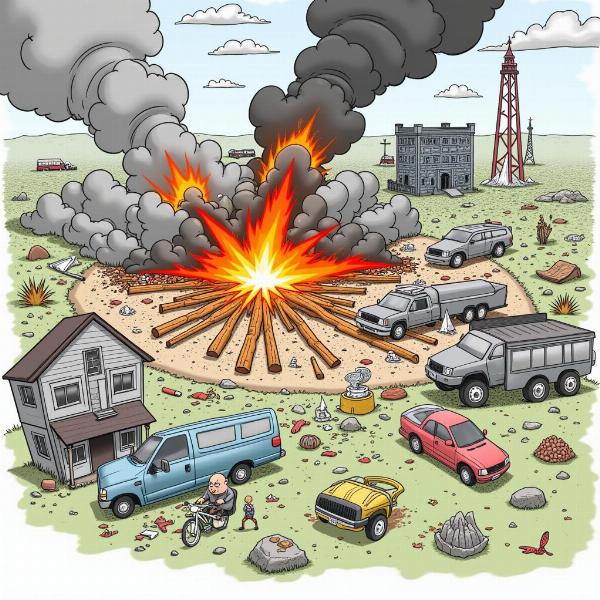Understanding the meaning of “calamitous” is crucial for anyone navigating the complexities of the English language, especially within the Indian context. This word carries a heavy weight, signifying events and situations of severe misfortune and disaster. Knowing its nuances in Hindi can enrich your communication and comprehension.
What Does Calamitous Mean?
Calamitous describes something that brings about or involves a calamity. It signifies a grave misfortune or disaster, often causing widespread destruction, suffering, and loss. Think of natural disasters, economic crises, or personal tragedies that leave a devastating impact.  Illustration of a calamitous event
Illustration of a calamitous event
Calamitous Meaning in Hindi: Exploring Synonyms and Usage
In Hindi, several words capture the essence of “calamitous.” These include:
- विनाशकारी (vinaashakaaree): This translates to “destructive” and emphasizes the ruinous nature of a calamitous event.
- आपत्तिजनक (aapattijanak): Meaning “disastrous” or “causing distress,” this word highlights the hardship and suffering associated with calamity.
- भयावह (bhayaavah): This term conveys a sense of dread and terror, emphasizing the frightening aspect of a calamitous situation.
- प्रलयंकारी (pralayankaaree): This word signifies “catastrophic” and is often used to describe events of immense scale and destruction.
Choosing the most appropriate Hindi equivalent depends on the specific context and the nuance you wish to convey. For instance, describing a devastating earthquake, “प्रलयंकारी (pralayankaaree)” might be the most fitting term. Whereas, for a personal tragedy, “आपत्तिजनक (aapattijanak)” might be more suitable.
Understanding the Context: When to Use “Calamitous”
The word “calamitous” is reserved for situations of significant gravity. It’s not used to describe everyday mishaps or minor inconveniences. Consider these examples:
- Correct usage: The calamitous floods left thousands homeless.
- Incorrect usage: Losing my keys was a calamitous start to the day.
In the first example, “calamitous” accurately describes the devastating impact of the floods. The second example, however, trivializes the word by applying it to a minor inconvenience.
Calamitous vs. Disastrous: Is There a Difference?
While often used interchangeably, “calamitous” and “disastrous” disastrous meaning in hindi have subtle differences. “Disastrous” implies a negative outcome or a significant failure, while “calamitous” emphasizes the severity and widespread impact of the misfortune, often involving great loss and suffering.
Examples of Calamitous Events
History is replete with calamitous events that have shaped the world we live in. These include natural disasters like the 2004 Indian Ocean tsunami, the Bhopal gas tragedy, and the Chernobyl disaster. These events serve as stark reminders of the devastating power of calamities and the importance of preparedness and mitigation.
How can we mitigate calamitous events?
While some calamitous events are unavoidable, others can be mitigated through careful planning and preventative measures. For instance, building codes designed to withstand earthquakes can minimize damage and loss of life during seismic activity. Similarly, investing in early warning systems for natural disasters can help communities prepare and evacuate in a timely manner.
Conclusion
Understanding the meaning of “calamitous” in Hindi empowers you to communicate effectively and comprehend the gravity of unfortunate situations. By exploring its various synonyms and understanding its appropriate usage, you can enrich your vocabulary and gain a deeper understanding of this powerful word. Remembering the distinction between “calamitous” and related terms like “disastrous” allows for more precise and nuanced communication.
FAQ
- What is the closest Hindi translation of “calamitous”? While several words capture aspects of “calamitous,” विनाशकारी (vinaashakaaree) and प्रलयंकारी (pralayankaaree) are often the closest equivalents.
- Can “calamitous” be used to describe a minor inconvenience? No, “calamitous” is reserved for situations of significant gravity and widespread negative impact.
- What are some examples of calamitous events in India? The 2004 Indian Ocean tsunami, the Bhopal gas tragedy, and recurring floods are examples of calamitous events that have impacted India.
- How does “calamitous” differ from “disastrous”? “Calamitous” emphasizes the severity and widespread impact of misfortune, while “disastrous” refers to a generally negative outcome or failure.
- What is the importance of understanding “calamitous” in a multilingual context like India? Understanding such nuanced vocabulary enhances communication and allows for a deeper appreciation of the English language within the Indian context.
Meaning-Hindi.in is your one-stop solution for all your Hindi translation needs. We specialize in various translation services, from business and legal documents to technical manuals and website localization. Our team of expert translators ensures accurate and culturally sensitive translations, bridging the language gap for businesses and individuals alike. Need a document translated? Contact us at [email protected] or call us at +91 11-4502-7584. Meaning-Hindi.in is here to help!